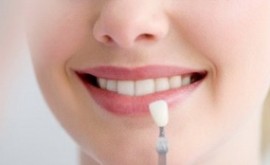A veneer can improve the colour and shape of your teeth. Great for disguising a discoloured or chipped tooth!
In practical terms, a veneer is a thin layer of porcelain that fits over the front surface of your tooth. You can chose a precise shade to match your existing teeth or to lighten your front teeth. The porcelain covers the whole of the front of the tooth, with a thicker section replacing the broken part. Veneers can also be used to close small gaps, when orthodontics (braces) are not suitable. If one tooth is slightly out of position, a veneer can bring it into line with the others.
For more information on veneers, please read below or contact us. Our friendly team will be glad to advise.
Veneers make teeth look natural and healthy. Very little preparation of the tooth is needed as veneers are very thin and are held in place by a special, strong adhesive. Some veneers don't need any preparation at all. Generally a veneer will require two to three dental visits.
A small amount of the outer enamel surface of the tooth may be removed in the first visit – the same as the thickness of the veneer to be fitted – so that the tooth stays the same size. A local anaesthetic may be used to make sure that there is no discomfort, but often this is not required. Your tooth will look the same but just feel a bit rougher. Once the tooth has been prepared, the dental team will take an impression of the tooth so that the veneer can be custom made to fit. The colour of the surrounding teeth will be matched on a shade guide to get the right colour and ensure that the veneer will look like a natural tooth.
In the second visit, the dentist will show you the veneer to check you are happy with the shade and then bond it to the tooth. Our dental team may want to check and polish your veneer a week or so after it is fitted, and make sure that you are happy with it.
Veneers should last for many years but, as with normal teeth, they can chip or break, so you do need to take care of them. Small chips can be repaired, or a new veneer fitted if necessary.
Natural-coloured fillings can be used for minor repairs to front teeth but sometimes the tooth will not support the filling and it can be very difficult for broken tooth corners. You will always see a join between the tooth and the filling material, so they are not as attractive as veneers.
Crowns are better when teeth which need to be strengthened – either because they have broken, have been weakened by a very large filling, and sometimes more extensive root canal treatment may be required if the tooth's nerve has been damaged.




